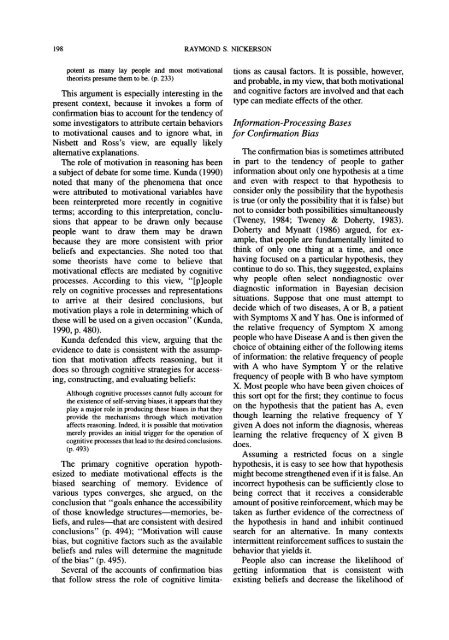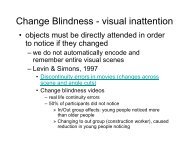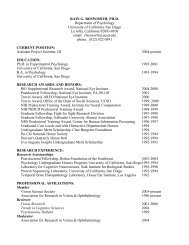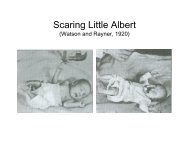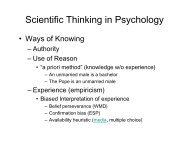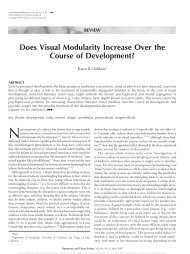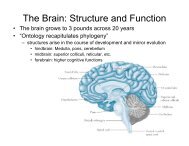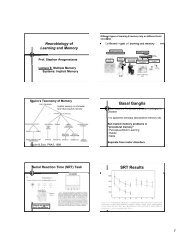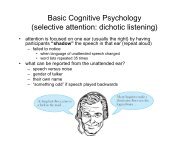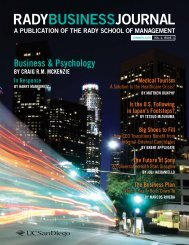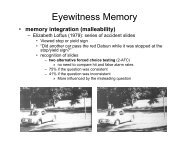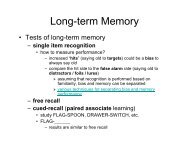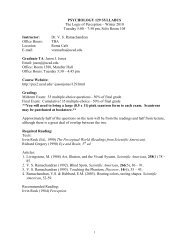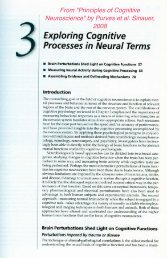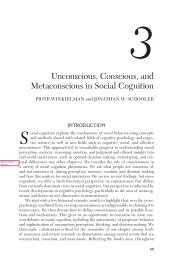Confirmation Bias: A Ubiquitous Phenomenon in Many Guises
Confirmation Bias: A Ubiquitous Phenomenon in Many Guises
Confirmation Bias: A Ubiquitous Phenomenon in Many Guises
You also want an ePaper? Increase the reach of your titles
YUMPU automatically turns print PDFs into web optimized ePapers that Google loves.
198 RAYMOND S. NICKERSON<br />
potent as many lay people and most motivational<br />
theorists presume them to be. (p. 233)<br />
This argument is especially <strong>in</strong>terest<strong>in</strong>g <strong>in</strong> the<br />
present context, because it <strong>in</strong>vokes a form of<br />
confirmation bias to account for the tendency of<br />
some <strong>in</strong>vestigators to attribute certa<strong>in</strong> behaviors<br />
to motivational causes and to ignore what, <strong>in</strong><br />
Nisbett and Ross's view, are equally likely<br />
alternative explanations.<br />
The role of motivation <strong>in</strong> reason<strong>in</strong>g has been<br />
a subject of debate for some time. Kunda (1990)<br />
noted that many of the phenomena that once<br />
were attributed to motivational variables have<br />
been re<strong>in</strong>terpreted more recently <strong>in</strong> cognitive<br />
terms; accord<strong>in</strong>g to this <strong>in</strong>terpretation, conclusions<br />
that appear to be drawn only because<br />
people want to draw them may be drawn<br />
because they are more consistent with prior<br />
beliefs and expectancies. She noted too that<br />
some theorists have come to believe that<br />
motivational effects are mediated by cognitive<br />
processes. Accord<strong>in</strong>g to this view, "[p]eople<br />
rely on cognitive processes and representations<br />
to arrive at their desired conclusions, but<br />
motivation plays a role <strong>in</strong> determ<strong>in</strong><strong>in</strong>g which of<br />
these will be used on a given occasion" (Kunda,<br />
1990, p. 480).<br />
Kunda defended this view, argu<strong>in</strong>g that the<br />
evidence to date is consistent with the assumption<br />
that motivation affects reason<strong>in</strong>g, but it<br />
does so through cognitive strategies for access<strong>in</strong>g,<br />
construct<strong>in</strong>g, and evaluat<strong>in</strong>g beliefs:<br />
Although cognitive processes cannot fully account for<br />
the existence of self-serv<strong>in</strong>g biases, it appears that they<br />
play a major role <strong>in</strong> produc<strong>in</strong>g these biases <strong>in</strong> that they<br />
provide the mechanisms through which motivation<br />
affects reason<strong>in</strong>g. Indeed, it is possible that motivation<br />
merely provides an <strong>in</strong>itial trigger for the operation of<br />
cognitive processes that lead to the desired conclusions,<br />
(p. 493)<br />
The primary cognitive operation hypothesized<br />
to mediate motivational effects is the<br />
biased search<strong>in</strong>g of memory. Evidence of<br />
various types converges, she argued, on the<br />
conclusion that "goals enhance the accessibility<br />
of those knowledge structures—memories, beliefs,<br />
and rules—that are consistent with desired<br />
conclusions" (p. 494); "Motivation will cause<br />
bias, but cognitive factors such as the available<br />
beliefs and rules will determ<strong>in</strong>e the magnitude<br />
of the bias" (p. 495).<br />
Several of the accounts of confirmation bias<br />
that follow stress the role of cognitive limita-<br />
tions as causal factors. It is possible, however,<br />
and probable, <strong>in</strong> my view, that both motivational<br />
and cognitive factors are <strong>in</strong>volved and that each<br />
type can mediate effects of the other.<br />
Information-Process<strong>in</strong>g Bases<br />
for <strong>Confirmation</strong> <strong>Bias</strong><br />
The confirmation bias is sometimes attributed<br />
<strong>in</strong> part to the tendency of people to gather<br />
<strong>in</strong>formation about only one hypothesis at a time<br />
and even with respect to that hypothesis to<br />
consider only the possibility that the hypothesis<br />
is true (or only the possibility that it is false) but<br />
not to consider both possibilities simultaneously<br />
(Tweney, 1984; Tweney & Doherty, 1983).<br />
Doherty and Mynatt (1986) argued, for example,<br />
that people are fundamentally limited to<br />
th<strong>in</strong>k of only one th<strong>in</strong>g at a time, and once<br />
hav<strong>in</strong>g focused on a particular hypothesis, they<br />
cont<strong>in</strong>ue to do so. This, they suggested, expla<strong>in</strong>s<br />
why people often select nondiagnostic over<br />
diagnostic <strong>in</strong>formation <strong>in</strong> Bayesian decision<br />
situations. Suppose that one must attempt to<br />
decide which of two diseases, A or B, a patient<br />
with Symptoms X and Y has. One is <strong>in</strong>formed of<br />
the relative frequency of Symptom X among<br />
people who have Disease A and is then given the<br />
choice of obta<strong>in</strong><strong>in</strong>g either of the follow<strong>in</strong>g items<br />
of <strong>in</strong>formation: the relative frequency of people<br />
with A who have Symptom Y or the relative<br />
frequency of people with B who have symptom<br />
X. Most people who have been given choices of<br />
this sort opt for the first; they cont<strong>in</strong>ue to focus<br />
on the hypothesis that the patient has A, even<br />
though learn<strong>in</strong>g the relative frequency of Y<br />
given A does not <strong>in</strong>form the diagnosis, whereas<br />
learn<strong>in</strong>g the relative frequency of X given B<br />
does.<br />
Assum<strong>in</strong>g a restricted focus on a s<strong>in</strong>gle<br />
hypothesis, it is easy to see how that hypothesis<br />
might become strengthened even if it is false. An<br />
<strong>in</strong>correct hypothesis can be sufficiently close to<br />
be<strong>in</strong>g correct that it receives a considerable<br />
amount of positive re<strong>in</strong>forcement, which may be<br />
taken as further evidence of the correctness of<br />
the hypothesis <strong>in</strong> hand and <strong>in</strong>hibit cont<strong>in</strong>ued<br />
search for an alternative. In many contexts<br />
<strong>in</strong>termittent re<strong>in</strong>forcement suffices to susta<strong>in</strong> the<br />
behavior that yields it.<br />
People also can <strong>in</strong>crease the likelihood of<br />
gett<strong>in</strong>g <strong>in</strong>formation that is consistent with<br />
exist<strong>in</strong>g beliefs and decrease the likelihood of


